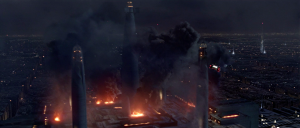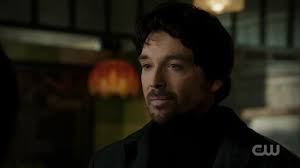The 8 Star Wars Episode films so far have contained three depictions of genocide; Star Wars touches upon many uncomfortable themes … and this surely is one of them. But it also always seeks to express in music what sometimes pictures and dialogue cannot. What do these soundtracks tell us of such horrors?
The Jedi Genocide: Order ’66
Order 66 in Revenge of the Sith is the first genocide that occurs in the storyline of Star Wars, although it is not the first occasion in which a mass-killing of non-combattants happens as that is the destruction of the Tusken Raider village by Anakin in Attack of the Clones. The sequence of scenes is scored via a single piece of music, under the title Anakin’s Betrayal.
The sequence of scenes depicts the end of various Jedi Masters intercut with Anakin’s march on the Coruscant Jedi Temple. Reaction shots from, in particular, Yoda relay an image of the shock that this tragedy sends through the Force. That we are dealing with a genocidal crime is emphasized in the depiction of Anakin making no exception for the Jedi Youngling. I always admired the courage of George Lucas to show this the way he did: it makes clear there is no return or redemption for Anakin from this darkness, except perhaps within the one-on-one intimacy of his final moments with his son.
Reaction shots from, in particular, Yoda relay an image of the shock that this tragedy sends through the Force. That we are dealing with a genocidal crime is emphasized in the depiction of Anakin making no exception for the Jedi Youngling. I always admired the courage of George Lucas to show this the way he did: it makes clear there is no return or redemption for Anakin from this darkness, except perhaps within the one-on-one intimacy of his final moments with his son.
The score underlines the terrible sadness of it all. Not only do the strings put down a bed of sorrowful and mournful music. But on top of that Williams orchestrates a wailing choir that is almost as massive as the choir that does the Duel of the Fates, Battle of the Heroes and the funeral scores. The horns and trumpets accentuate particular deaths in the scenes or particular responses to it by Yoda. It all ends on a very subdued and tragic note with just a few voices and over the images of the burning Jedi Temple.
This score brought tears to my eyes when I saw the film for the first time in 2005. It is hauntingly beautiful and painfully tragic. I think there is no other piece of soundtrack in Star Wars that is quite like it. The music perfectly conveys the definiteness of what is lost to the Galaxy on that night. There is no return or recovery from this and in many ways this genocide is not the end, but the start of a horrid tragedy that shall come to affect the lives of all. The music almost seems to suggest that the true tragedy here is that all this is happening while the clubs, bars, opera houses and theaters in Coruscant and elsewhere go about their business as usual. This deep loss that rips the heart out of the Republic occurs without much public attention.
I think there is no other piece of soundtrack in Star Wars that is quite like it. The music perfectly conveys the definiteness of what is lost to the Galaxy on that night. There is no return or recovery from this and in many ways this genocide is not the end, but the start of a horrid tragedy that shall come to affect the lives of all. The music almost seems to suggest that the true tragedy here is that all this is happening while the clubs, bars, opera houses and theaters in Coruscant and elsewhere go about their business as usual. This deep loss that rips the heart out of the Republic occurs without much public attention.
The Destruction of Alderaan
The destruction of Alderaan occurs almost by surprise in A New Hope. The planet is destroyed without us having any chance to connect with the people living on its surface. The planet is destroyed because it simply happens to be at the wrong place at the wrong time, and of course as a means by Tarkin to pressure Leia he holds captive. That Alderaan was a infamous supporter of the Rebellion probably also helped seal her fate.
The score to this genocide seemingly couldn’t be more different than the Order 66 one. Yet the wind instruments play a fast off-set pattern that is very similar to the slow pattern played by the strings in the Order 66 score. There is no choir here, reminding us that except for Leia Alderaan is all but faceless to us. Obi Wan hears the ‘voices that screamed out and suddenly were silenced’ through the Force. Very similar to Yoda’s reaction to Order 66. But the piece is dominated by eerie almost militaristic trumpetry.
The score perfectly captures the swiftness and cold-heartedness with which Tarkin decides to end the lives of the billions stuck on Alderaan’s surface. The terror it strikes in Leia’s heart and the inevitability of it all. Unlike the Order 66 genocide however this one will not go unseen. Alderaan will not pass into ‘myth’ within a few decades as the Jedi would. Rather Alderaan will stand out as a warning what ‘Empire’ truly means. The revelatory nature of this criminal act as something finally pulls away any disguise off the Empire’s evil face is emphasized by the score in a beautifully scary way.
The terror it strikes in Leia’s heart and the inevitability of it all. Unlike the Order 66 genocide however this one will not go unseen. Alderaan will not pass into ‘myth’ within a few decades as the Jedi would. Rather Alderaan will stand out as a warning what ‘Empire’ truly means. The revelatory nature of this criminal act as something finally pulls away any disguise off the Empire’s evil face is emphasized by the score in a beautifully scary way.
The Destruction of the New Republic
The Destruction of the Republic by the Star Killer weapon happens when Snoke fears that Luke Skywalker may soon be joining the side of his opponents. It is General Hux who recommend, no urges, him to deploy the weapon and so the fate of the Hosnian Prima system, the rotating capital of the New Republic is doomed.
The Force Awakens does add a few elements to this genocide that the previous two do not display. Of all three this is the most public one. Not only is the firing from Star Killer base visible from the surface of planets in other systems, such as Tokadana where Han en Finn watch things unfold. This is not the sneaky mass murder that occurs far away from public perception, as with Order 66, nor is it the annihilation by a force that is close to its target but cares little for it as in the destruction of Alderaan by the Death Star. Star Killer base strikes from far, far away like a terror organization might do. Hux’s speech also makes clear this is not an accidental system of which they make an example. It is pure hatred that drives them to select this target, to do so from afar, and to do so in such a way that all in the Galaxy can see.
Of all three this is the most public one. Not only is the firing from Star Killer base visible from the surface of planets in other systems, such as Tokadana where Han en Finn watch things unfold. This is not the sneaky mass murder that occurs far away from public perception, as with Order 66, nor is it the annihilation by a force that is close to its target but cares little for it as in the destruction of Alderaan by the Death Star. Star Killer base strikes from far, far away like a terror organization might do. Hux’s speech also makes clear this is not an accidental system of which they make an example. It is pure hatred that drives them to select this target, to do so from afar, and to do so in such a way that all in the Galaxy can see.
For the score to this crime Williams draws upon his Order 66 composition. In fact the piece called The Star Killer in the score to The Force Awakens combines much of the same atmospherics as Anakin’s Betrayal. Sadness prevails and the tragedy of what happens is emphasized.  It is orchestrated as a strings only piece, reflecting this ‘death coming from afar’ nature of the crime. No horns or trombones to ‘anchor’ the piece or to add a touch of military might. The First Order in The Force Awakens is a terrorist bunch of fanatics, a high-tech and sumptuously resourced version of Isis but not an ‘Empire’. Interestingly the score for the destruction of the New Republic ends on a familiar note … exactly the chord with which Anakin’s Betrayal starts.
It is orchestrated as a strings only piece, reflecting this ‘death coming from afar’ nature of the crime. No horns or trombones to ‘anchor’ the piece or to add a touch of military might. The First Order in The Force Awakens is a terrorist bunch of fanatics, a high-tech and sumptuously resourced version of Isis but not an ‘Empire’. Interestingly the score for the destruction of the New Republic ends on a familiar note … exactly the chord with which Anakin’s Betrayal starts.
Conclusion
Order 66, the destruction of Alderaan and the destruction of the New Republic are three related yet very different depictions of genocides in the Star Wars saga. The narrative differences between them are not only reflected in the way they are presented on screen, but also in the score.
Advertisements Share this:




